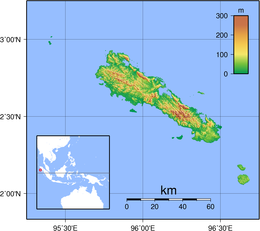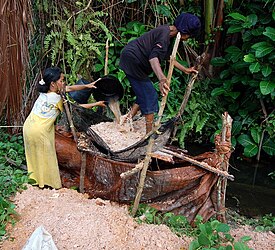Simeulue
 Topographic map of Simeulue | |
 | |
| Geography | |
|---|---|
| Location | South East Asia |
| Coordinates | 02°37′48″N 96°05′24″E / 2.63000°N 96.09000°E |
| Area | 1,754 km2 (677 sq mi) |
| Highest elevation | 567 m (1860 ft) |
| Highest point | unnamed |
| Administration | |
Indonesia | |
| Province | Aceh |
| Regency | Simeulue Regency |
| Largest settlement | Sinabang |
| Demographics | |
| Population | 93,762 (mid 2021 estimate) |
| Pop. density | 51.0/km2 (132.1/sq mi) |

Simeulue /sɪməˈluːeɪ/ is an island of Indonesia, 150 kilometres (93 mi) off the west coast of Sumatra. It covers an area of 1,754 square kilometres (677 square miles), including minor offshore islands. It had a population of 80,674 at the 2010 census[1] and 92,865 at the 2020 census.[2] The official estimate as at mid 2021 was 93,762.[3] Its capital is Sinabang.
Simeulue was once a part of West Aceh Regency but was split off in 1999 and became a separate Simeulue Regency.
Demographics
[edit]From the ethnic point of view the inhabitants of Simeulue are similar to the people of neighboring Nias Island. Two languages and a number of dialects are spoken on the island: Simeulue and Sigulai, which are different from the languages spoken in the north of Sumatra.[4] The majority of the island's population is Muslim.
History
[edit]In the 17th century Tengku Di brought Islam to the island and the first mosque was built in Salur villiage[5] .
Simeulue was historically known to European mariners as "Hog Island"[6] and served as a landfall for ships seeking ports on the west coast of Sumatra for the pepper trade. It was also known as "Pulo Oo", or "Coconut Island".[6] Some historians suggest the fictional islands of Lilliput and Blefuscu in Gulliver's Travels (1726) might be described as two of Simeulue's remote islands in the Indian Ocean: Devayan and Sigulai.
In 1901 during the Aceh War the Dutch colonial empire government took control of Simeulue[5]. During World War II the Dutch admitted to Japan and there was set up a regiment made up the Simeuluean population.
1904 Tsunami
[edit]On the 4th of January 1907 the 1907 Sumatra earthquake with a 7.5-8 magnitude earthquake shook the seabed off the West coast of Simeulue and caused a tsunami with waves reported to be 10-15 meters high[7]. This tsunami led to the death of more than 50% (some report as high as 70%) of the Simeulue population.
2004 Indian Ocean earthquake
[edit]Simeulue was close to the epicenter of the 9.3 magnitude 26 December 2004 earthquake.
On 28 March 2005, an 8.7 magnitude earthquake struck with its epicenter just off the south end of the island.[8] During the earthquake, Simeulue rose at least 2 metres (6 ft) on the western coast; this left the flat top of its coral reefs above high tide. On the east coast, the land was submerged, with seawater flooding fields and settlements.[9]
Although Simeulue Island was only 60 kilometers from the epicenter of the 2004 earthquake, whereas Banda Aceh – the city that was hit hardest by the tsunami – was about 250 kilometers away, only seven residents on Simeulue died, while the remaining 70,000 survived[10]. This has been argued to have been due to local wisdom of the 'smong' (meaning Tsunami) that educates the listener in the warning signs of a tsunami and advises them to seek higher ground[11][12][13][14][15].
Oral Traditions
[edit]Historically, Simeulue society, culture and practices are guided by ancestral indigenous wisdom which are past down through oral tradition. These oral traditions include Nandong (humming with kedang and or violin)[16], nanga-nanga (sung storytelling) and mananga-nanga (lullabies)[17]. These traditions have allowed for stories such as the 'smong' to be passed down generationally[10]
Tourism
[edit]Over the past ten years Simeulue has become a popular surfing destination. The southwest-facing portion of the island is home to surf resorts.
See also
[edit]References
[edit]- ^ Biro Pusat Statistik, Jakarta, 2011.
- ^ Badan Pusat Statistik, Jakarta, 2021.
- ^ Badan Pusat Statistik, Jakarta, 2021.
- ^ BPS Kabupaten Simeulue (2003). Simeulue Dalam Angka 2012. BadanPusatStatistik.Com. ISBN 978-0-0100-0021-4.
- ^ a b Rahman, Alfi (2017). "Development Processes of Indigenous Knowledge on Tsunami Risk Reduction to Increase Community Resilience: The Case of the Smong in Simeulue Island, Aceh, Indonesia" (PDF). Tohoku University Repository.
- ^ a b JH Moor Notices of the Indian Archipelago (1837) (p103); retrieved 27 January 2019
- ^ Kanamori, Hiroo; Rivera, Luis; Lee, William H. K. (2010-10-01). "Historical seismograms for unravelling a mysterious earthquake: The 1907 Sumatra Earthquake". Geophysical Journal International. 183 (1): 358–374. doi:10.1111/j.1365-246X.2010.04731.x. ISSN 0956-540X.
- ^ "Gibbons, Helen (April 2005) "Second Tsunami Causes Damage in Indonesia—USGS Scientists Post Observations on the World Wide Web" United States Geological Survey". Archived from the original on 2016-12-31. Retrieved 2014-11-08.
- ^ Saved by tsunami folklore, BBC News From Our Correspondent, 10 March 2007
- ^ a b Sutton, Stephen A.; Paton, Douglas; Buergelt, Petra; Sagala, Saut; Meilianda, Ella (2021-11-01). "Nandong smong and tsunami lullabies: Song and music as an effective communication tool in disaster risk reduction". International Journal of Disaster Risk Reduction. 65: 102527. doi:10.1016/j.ijdrr.2021.102527. ISSN 2212-4209.
- ^ Rahman, Alfi; Nazaruddin, Muzayin; Januriyadi, Nurul Fajar; Affan, Muzailin (2024-09-01). "Cross-generational Smong narratives in Aceh's tsunami resilience". Asia-Pacific Journal of Regional Science. 8 (3): 943–970. doi:10.1007/s41685-024-00346-6. ISSN 2509-7954.
- ^ Rahman, Alfi; Sakurai, Aiko; Munadi, Khairul (2018-08-01). "The analysis of the development of the Smong story on the 1907 and 2004 Indian Ocean tsunamis in strengthening the Simeulue island community's resilience". International Journal of Disaster Risk Reduction. 29: 13–23. doi:10.1016/j.ijdrr.2017.07.015. ISSN 2212-4209. S2CID 165012369.
- ^ McAdoo, Brian G.; Dengler, Lori; Prasetya, Gegar; Titov, Vasily (June 2006). "Smong: How an Oral History Saved Thousands on Indonesia's Simeulue Island during the December 2004 and March 2005 Tsunamis". Earthquake Spectra. 22 (S3): 661–669. doi:10.1193/1.2204966. ISSN 8755-2930. S2CID 111256838.
- ^ Suciani, A.; Islami, Z. R.; Zainal, S.; Sofiyan; Bukhari (2018). ""Smong" as local wisdom for disaster risk reduction". IOP Conference Series: Earth and Environmental Science. 148 (1): 012005. doi:10.1088/1755-1315/148/1/012005. ISSN 1755-1315.
- ^ Pasotti, Jacopo (2014-12-10). "Smong: The Tsunami Story". Jacopo Pasotti. Retrieved 2018-07-29.
- ^ Ali, Hasbi; Ruslan, Ruslan (2018). "Preservation of Local Wisdom Culture (Local Genius) as an Effort to Establish the Character of the Nation". Atlantis Press. doi:10.2991/acec-18.2018.43. ISBN 978-94-6252-616-7.
{{cite journal}}: Cite journal requires|journal=(help) - ^ Lubis, Tasnim (2019). "Nanga-nanga in Simeulue Island". Journal of Oral Traditions. 1 (1): 17–21.
External links
[edit] Media related to Simeulue at Wikimedia Commons
Media related to Simeulue at Wikimedia Commons
